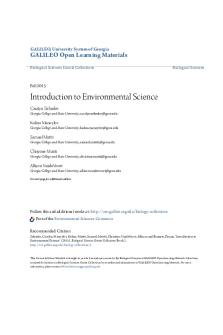Lecture 11 - Managing environmental quality PDF

| Title | Lecture 11 - Managing environmental quality |
|---|---|
| Course | Business, Government and Society |
| Institution | Aston University |
| Pages | 2 |
| File Size | 67 KB |
| File Type | |
| Total Downloads | 181 |
| Total Views | 208 |
Summary
Business Government and Society Lecture 11 – Managing Environmental QualityWhy is the environment in danger? Benefit from the environment in 3 ways: Amenity to be enjoyed Source of primary products Place to dump waste Free market cannot ensure all 3 uses are balanced Natural resources are non-exclu...
Description
Business Government and Society Lecture 11 – Managing Environmental Quality Why is the environment in danger? Benefit from the environment in 3 ways: 1. Amenity to be enjoyed 2. Source of primary products 3. Place to dump waste Free market cannot ensure all 3 uses are balanced
Natural resources are non-exclusive (people can’t be prevented from using them) No one can be charged for using the resources No price = no economic incentive to use the resources sparingly
Without government intervention, the environment will deteriorate Regulating Environmental Risk 2 types of externalities created by businesses: 1. Pollution 2. Resource depletion
Government mitigates the externalities by using environmental regulations Comparing costs to benefits is crucial when deciding whether a regulation should be passed
Cost-benefit Analysis = systematic calculation and comparison of the costs and benefits of a proposed action Costs include: -
Enforcement costs Capital and compliance costs to industry Potential job losses Higher consumer prices Reduced productivity
Benefits include: -
Ecological Health
Measuring the Benefits of Environmental Regulation 2 types of methods of calculating monetary benefits of environmental regulation Environment: contingent valuation This is used to measure the monetary value of ecosystem goods Health: the value of a statistical life This is used to measure the monetary value of better health due to reduced pollution
Criticisms of Cost-Benefit Analysis
Many benefits are long-term, most impact assessments in the UK use an appraisal period of 10 years Cost-benefit approaches compromise ecosystems...
Similar Free PDFs

Chapter 6 Managing Quality
- 4 Pages

Managing quality at Unilever
- 1 Pages

Managing quality in the 21st century
- 86 Pages

Environmental Science Lecture notes
- 25 Pages

Quality Control Lecture Notes
- 7 Pages

11 - Lecture notes 11
- 14 Pages

Lecture EE333 - lecture 11
- 21 Pages
Popular Institutions
- Tinajero National High School - Annex
- Politeknik Caltex Riau
- Yokohama City University
- SGT University
- University of Al-Qadisiyah
- Divine Word College of Vigan
- Techniek College Rotterdam
- Universidade de Santiago
- Universiti Teknologi MARA Cawangan Johor Kampus Pasir Gudang
- Poltekkes Kemenkes Yogyakarta
- Baguio City National High School
- Colegio san marcos
- preparatoria uno
- Centro de Bachillerato Tecnológico Industrial y de Servicios No. 107
- Dalian Maritime University
- Quang Trung Secondary School
- Colegio Tecnológico en Informática
- Corporación Regional de Educación Superior
- Grupo CEDVA
- Dar Al Uloom University
- Centro de Estudios Preuniversitarios de la Universidad Nacional de Ingeniería
- 上智大学
- Aakash International School, Nuna Majara
- San Felipe Neri Catholic School
- Kang Chiao International School - New Taipei City
- Misamis Occidental National High School
- Institución Educativa Escuela Normal Juan Ladrilleros
- Kolehiyo ng Pantukan
- Batanes State College
- Instituto Continental
- Sekolah Menengah Kejuruan Kesehatan Kaltara (Tarakan)
- Colegio de La Inmaculada Concepcion - Cebu








